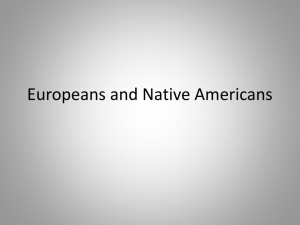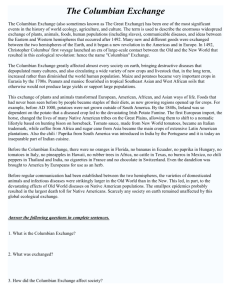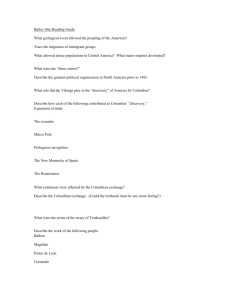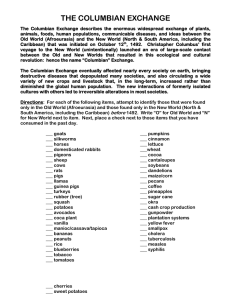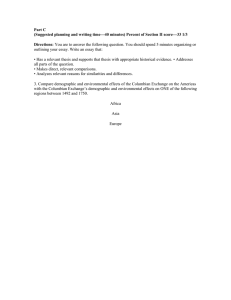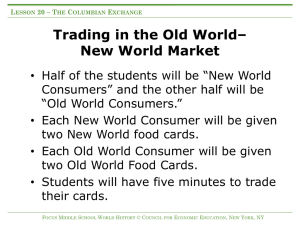The Columbian Exchange
advertisement
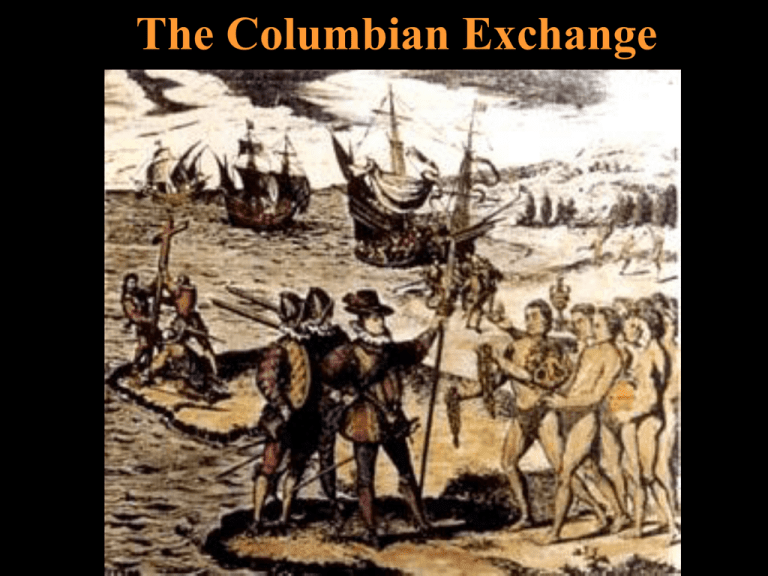
The Columbian Exchange Before 1492 Two very different ecosystems Two different disease pools Two sets of culturally diverse peoples Two sets of flora and fauna “...all the trees were as different from ours as day from night, and so the fruits, the herbage, the rocks, and all things.” -- Christopher Columbus Two biological ecosystems interchanged to create a new world ecology. According to historian Alfred Crosby, the exchange of plants, animals and pathogens between the two hemispheres was biologically “the most spectacular thing that has ever happened to humans," and he coined the phenomenon the Columbian Exchange. An Exchange of Pathogens The smallpox virus A Demographic Collapse Aztecs afflicted with Smallpox In Mexico alone, the native population fell from roughly 30 million in 1519 to only 3 million in 1568. Modern-day victims of smallpox Livestock A Plague of Sheep Chickens and Eggs The Cowboys of the Americas Vaquero Gaucho Llanero Cowboy The greatest impact of the Columbian Exchange was the exchange of different food crops. Sweet Potatos Cassava Potatos The Exchange of Plants and Animals Originally from the Western Hemisphere • Potato • Maize (corn) • Manioc (cassava, tapioca) • Sweet potato • Tomato • Cacao (chocolate) • Squash • Chili peppers • Pumpkin • Papaya • Guava • Tobacco • Avocado • Pineapple • Beans (most varieties, including phaseolus vulgaris) • • • • Peanuts Certain cottons Rubber Turkeys Originally from the Eastern Hemisphere • Sugar • Olive oil • Various grains (Wheat, rice, rye, barley, oats) • Grapes • Coffee • Horses • Cattle • Pigs • Goats • Sheep • Chickens • Various fruit trees (pear, apple, peach, orange, lemon, pomegranate, fig, banana) • Chick peas • Melons • Radishes • A wide variety of weeds and grasses • Cauliflower • Cabbage An Increase in Food Supply Helped Populations to Rise The eventual result of all the exchanging of different food crops was a dramatic increase in food supply, which in turn caused a rise in population. How and why did this happen? An entirely new food plant or set of food plants permits the utilization of soils and seasons that have previously gone unused, thus causing a real jump in food production and, therefore, population. The benefits went both ways. Some Tropical Plants from the Old World Some Tropical Plants from the New World Maize/Corn Sugar, Tobacco and Slavery Africans lament the loss of their fellow countrymen. MAP 26.2 The Atlantic slave trade, 1500-1800. The Potato The potato grows well in the temperate climate of northern Europe and produces three times as much food per unit of land as wheat or any other grain. The Poor Person’s Food The Bank of England Between 1781 and 1845, the Irish population doubled from four to eight million. Probably half of this population depended on the potato for survival. The Great Irish Famine Over one million died of starvation and disease, and almost two million emigrated to the United States and Britain. The Columbian Exchange The effects of the columbian exchange are still with us today. Bit by bit, we are becoming more homogenized, and the world is becoming smaller. Is the world growing more the same?
